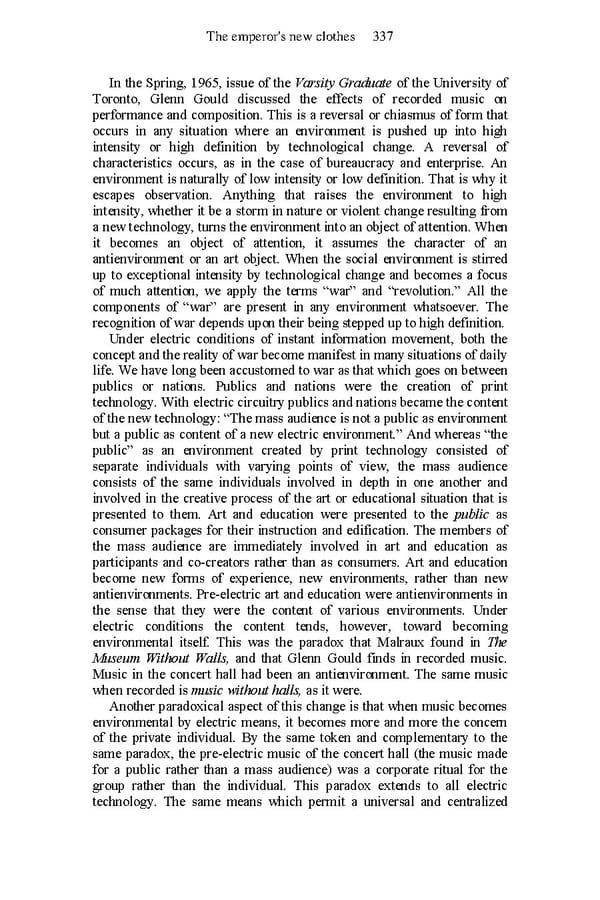The emperor's new clothes 337 In the Spring, 1965, issue of the Varsity Graduate of the University of Toronto, Glenn Gould discussed the effects of recorded music on performance and composition. This is a reversal or chiasmus of form that occurs in any situation where an environment is pushed up into high intensity or high definition by technological change. A reversal of characteristics occurs, as in the case of bureaucracy and enterprise. An environment is naturally of low intensity or low definition. That is why it escapes observation. Anything that raises the environment to high intensity, whether it be a storm in nature or violent change resulting from a new technology, turns the environment into an object of attention. When it becomes an object of attention, it assumes the character of an antienvironment or an art object. When the social environment is stirred up to exceptional intensity by technological change and becomes a focus of much attention, we apply the terms “war” and “revolution.” All the components of “war” are present in any environment whatsoever. The recognition of war depends upon their being stepped up to high definition. Under electric conditions of instant information movement, both the concept and the reality of war become manifest in many situations of daily life. We have long been accustomed to war as that which goes on between publics or nations. Publics and nations were the creation of print technology. With electric circuitry publics and nations became the content of the new technology: “The mass audience is not a public as environment but a public as content of a new electric environment.” And whereas “the public” as an environment created by print technology consisted of separate individuals with varying points of view, the mass audience consists of the same individuals involved in depth in one another and involved in the creative process of the art or educational situation that is presented to them. Art and education were presented to the public as consumer packages for their instruction and edification. The members of the mass audience are immediately involved in art and education as participants and co-creators rather than as consumers. Art and education become new forms of experience, new environments, rather than new antienvironments. Pre-electric art and education were antienvironments in the sense that they were the content of various environments. Under electric conditions the content tends, however, toward becoming environmental itself. This was the paradox that Malraux found in The Museum Without Walls, and that Glenn Gould finds in recorded music. Music in the concert hall had been an antienvironment. The same music when recorded is music without halls, as it were. Another paradoxical aspect of this change is that when music becomes environmental by electric means, it becomes more and more the concern of the private individual. By the same token and complementary to the same paradox, the pre-electric music of the concert hall (the music made for a public rather than a mass audience) was a corporate ritual for the group rather than the individual. This paradox extends to all electric technology. The same means which permit a universal and centralized
 Essential McLuhan Page 343 Page 345
Essential McLuhan Page 343 Page 345